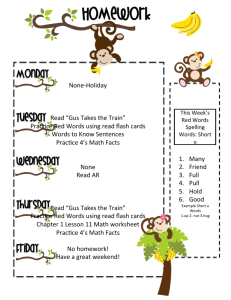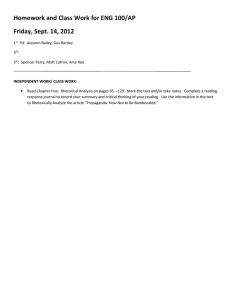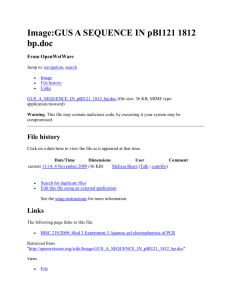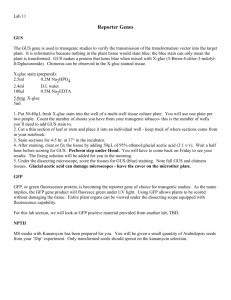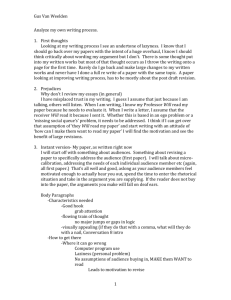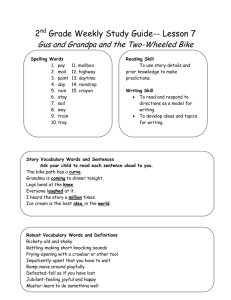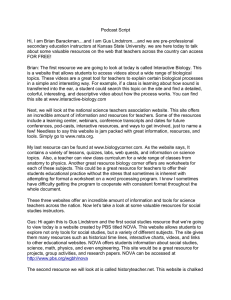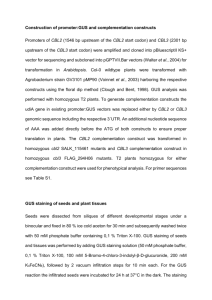R. Gus Jespersen University of Washington Winkenwerder 215 College of Forest Resources
advertisement
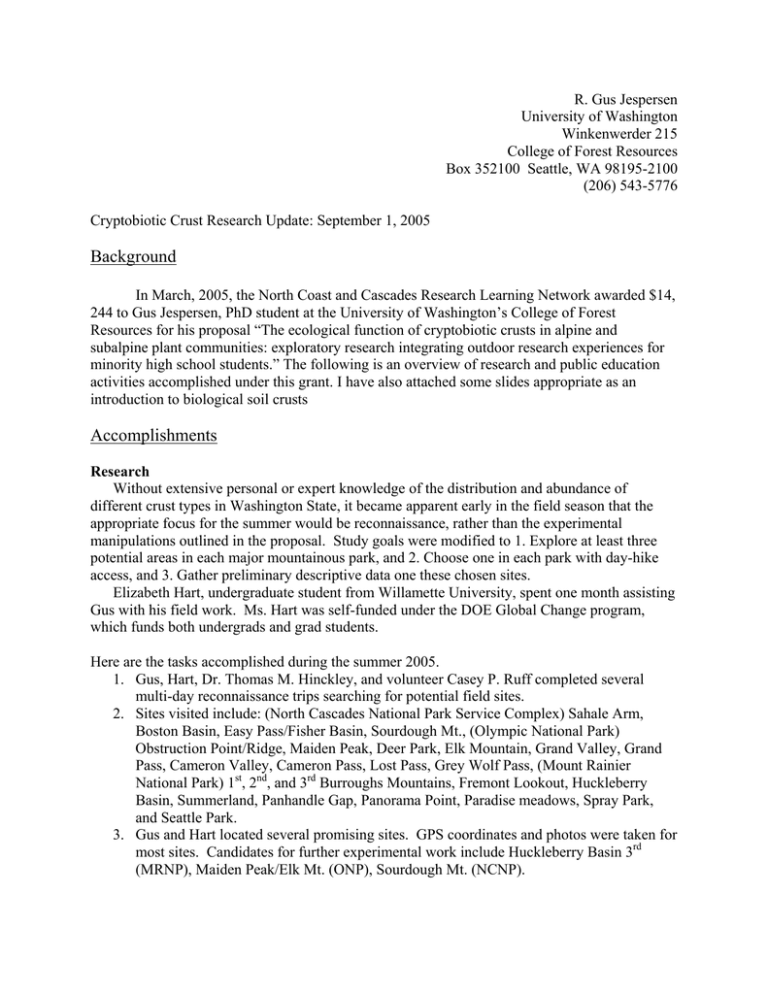
R. Gus Jespersen University of Washington Winkenwerder 215 College of Forest Resources Box 352100 Seattle, WA 98195-2100 (206) 543-5776 Cryptobiotic Crust Research Update: September 1, 2005 Background In March, 2005, the North Coast and Cascades Research Learning Network awarded $14, 244 to Gus Jespersen, PhD student at the University of Washington’s College of Forest Resources for his proposal “The ecological function of cryptobiotic crusts in alpine and subalpine plant communities: exploratory research integrating outdoor research experiences for minority high school students.” The following is an overview of research and public education activities accomplished under this grant. I have also attached some slides appropriate as an introduction to biological soil crusts Accomplishments Research Without extensive personal or expert knowledge of the distribution and abundance of different crust types in Washington State, it became apparent early in the field season that the appropriate focus for the summer would be reconnaissance, rather than the experimental manipulations outlined in the proposal. Study goals were modified to 1. Explore at least three potential areas in each major mountainous park, and 2. Choose one in each park with day-hike access, and 3. Gather preliminary descriptive data one these chosen sites. Elizabeth Hart, undergraduate student from Willamette University, spent one month assisting Gus with his field work. Ms. Hart was self-funded under the DOE Global Change program, which funds both undergrads and grad students. Here are the tasks accomplished during the summer 2005. 1. Gus, Hart, Dr. Thomas M. Hinckley, and volunteer Casey P. Ruff completed several multi-day reconnaissance trips searching for potential field sites. 2. Sites visited include: (North Cascades National Park Service Complex) Sahale Arm, Boston Basin, Easy Pass/Fisher Basin, Sourdough Mt., (Olympic National Park) Obstruction Point/Ridge, Maiden Peak, Deer Park, Elk Mountain, Grand Valley, Grand Pass, Cameron Valley, Cameron Pass, Lost Pass, Grey Wolf Pass, (Mount Rainier National Park) 1st, 2nd, and 3rd Burroughs Mountains, Fremont Lookout, Huckleberry Basin, Summerland, Panhandle Gap, Panorama Point, Paradise meadows, Spray Park, and Seattle Park. 3. Gus and Hart located several promising sites. GPS coordinates and photos were taken for most sites. Candidates for further experimental work include Huckleberry Basin 3rd (MRNP), Maiden Peak/Elk Mt. (ONP), Sourdough Mt. (NCNP). 4. Gus submitted a list of the most promising sites from each park to park officials at ONP and MRNP for review in late July/ early August. 5. Gus spent four days at Huckleberry Basin and Third Burroughs Mountain (MRNP) collecting descriptive data on two very diverse crust/ plant communities. 6. Gus and Casey Ruff spent two days collecting basic descriptive data in the Maiden Peak area at ONP. Gus and Casey then completed a forty mile reconnaissance loop through Grand Valley, Grand Pass, Cameron Valley/Pass, Lost Pass, and Grey Wolf Pass. Extensive subalpine and alpine crusts were noted during this trip. Olympic Typical clumped plant mix on Elk Mountain. Typical lichen crust/plant mix found in the Elk Mountain/ Maiden Peak area. Yellow-ish component is the lichen. Note pencil and boots for scale. Interestingly, structurally similar crusts exist in the 3rd Burroughs area at Rainier. Striped/clumped vegetation patterns near Maiden Peak. These clumps contain significant lichen crust coverage. A different perspective on these vegetation clumps. Close-up of a common lichen crust with plant associates near Maiden Peak. Mt. Rainier Plant associates above Panhandle Gap. This area was partially crusted. More non-crusted plants adjacent to a crusted area near Panhandle Gap. North Cascades Late-melting snowbank site on Easy Pass. Edges are crusted with a black lichen, becoming less and less predominant towards the center Another late-melting snowbank with crusted edges from Easy Pass. Public Education/Outreach: Backpacking Science Camp Dates: August 8-11, 15-18, 2005. Location: Fisher Creek Basin, North Cascades National Park Service Complex. Background: Also under the auspices of RLN grant, Gus, in partnership with EarthCorps, led two four-day backpacking science camps for Seattle-area high school students. The following will provide an overview of the educational activities undertaken with EarthCorps. Description of activities associated with camp: April- July 2005 Several organizational meetings preceded the summer. Partner organization EarthCorps assigned outreach intern Shannon Luoma to work with Gus on the project. Products from these meetings included a detailed itinerary, menu, recruiting materials, gear lists, and emergency plan. REI’s Gear Bank graciously agreed to lend tents, backpacks, stoves, and sleeping bags and pads to the project. Wendy Miller was the contact at REI for the gear loan. EarthCorps sent recruiting materials to Seattle-area high school science teachers. Applicants were accepted on a first-come, first-serve basis (approximately 20 applications were received). We required attendance at an orientation meeting July 28th. During this time Gus made several trips into the North Cascades to scout potential camp locations, including Fisher Basin. Fisher Basin was suggested by Paula Ogden-Muse, Park Education Specialist. Gus also initiated a dialogue with Parks personnel (Ogden-Muse, Regina Rochefort, Rosemary Seifried ) to reserve campsites. Elizabeth Wheat, M.S., a colleague of Gus’s from UW and a former high school science teacher in Brooklyn, NY, participated in the first week of the program. Darcy Batura, an environmental educator with WSU extension, contacted Shannon and Gus and expressed interest in participating for both field weeks. Shannon and Gus accepted the offer, and she participated for both weeks. August 1-8, 2005 Gus rented a satellite phone from Outfitter Satellites, Inc., and picked up gear from REI. Gus made an additional scouting trip into Fisher Basin with Krista Bartz, M.S. They located potential study sites that would be low-impact and exemplify the extensive community diversity in subalpine areas. Gus planned, purchased, and organized food. Shannon organized EarthCorps gear and medical supplies. Group 1 August 8 (same format for the 2nd week) Students had arrived at EarthCorps by 9:00 AM. Before departing, Shannon initiated an interactive ‘camp rules and norms’ session. Safety rules and regulations were stated and discussed, and students were asked to develop a set of behavioral boundaries to guide their backcountry experience. Departure from EarthCorps was around 11:00 AM. The group stopped in Marblemount to speak with rangers and pick up our permit. The group set up camp at a Lower Goodell group site. Following dinner, Gus delivered the first half of his lecture series for the course, focusing on the geologic origins of the North Cascades. August 9 The group arrived at the trailhead by 10:30 AM. The entire group completed the hike to Fisher Basin Camp by 5:00 PM without incident. Groups set up tents and prepared dinner. Following dinner Gus introduced the plans for the next day. August 10 Following breakfast, Wheat led a sensory-exploration exercise developed by Gus. Students were asked to spend ~20 minutes walking in silence, recording visual observations only. After 20 minutes, students formed pairs and compared notes. Next students were asked to spend ~20 minutes alone within sight distance, recording only sounds. Groups again formed and observations were discussed. Following this the whole group came together and shared their observations. Where appropriate, counselors offered insights into their observations. Perhaps unwittingly, the first 3 sounds the students discussed illuminated several of the major biological and physical features of the landscape… diverse pollinators, intense and variable wind, high energy water. Next Wheat introduced an activity of her own design. The group marched into a forest clearing, formed pairs, and blindfolded one member of each pair. The “eyes” of the pair then led the blindfolded person to a tree of their choosing. The blindfolded individual was granted ~5 minutes to explore their tree without seeing it. Following this, the blindfolded person was led back to the center, where blindfolds were removed. We then asked the formerly blindfolded people to find the trees they had explored. Students were remarkably adept at this. All students were allowed to complete this activity. Gus led the students to a lunch spot near Fisher Creek. Following lunch Gus completed his lecture series, this time focusing on biological features of our surroundings as a reflection of our geologic history. Next Gus and Wheat led students through an activity titled “Quantifying our landscape: a transect-based approach.” Students laid out 25 ft. tapes and recorded vegetation composition along the lines. Data sheets did not require accurate names, but they did require a thoughtful description of plant traits (i.e. leaf size and shape, height, etc.) Student groups completed 3 transects on both north and south-facing slopes. Next students compiled their data for each transect into percent cover, and labeled their communities based on dominant plant features. Following this the group hiked back to camp and prepared dinner. August 11 Students awoke ~5:30 AM to break camp. We were on the trail by 7:30, and arrived at the vans ~11:00 AM. We stopped for ice cream at Cascadian Farm Roadside Stand, a popular decision with the students. We arrived at EarthCorps by 3:30, 30 minutes before parents were scheduled to arrive. Group 2 August 15-18 The format ended up being quite different, owing to a 10 AM departure from EC on the first day, which allowed us to hike in the first day. Also, Beth Wheat did not participate this week. Everyone but one student arrived at the pass by 7:30 PM. This particular student refused to continue approximately 200’ vertical from Easy Pass despite encouragement from Shannon and Batura. The student requested that she be hiked out. Batura agreed to hike the student out. They arrived back at the vehicles by 11:00 PM, and in Marblemount by 12:00 AM. The student’s mother arrived ~3 AM to retrieve her daughter. Batura hiked in the following day. August 16th proceeded just as the previous week’s field day, with a few exceptions. This group of students demonstrated greater overall curiosity and maturity, allowing activities to be completed faster. By dinner students had compiled data, labeled communities, and completed some wonderfully detailed sketches of their transects as shown in the data. We were then able to discuss sampling techniques in the context of their data and perceived methodological shortcomings. August 17th was devoted to group projects. Following breakfast, the group split in half, and students ventured out for ~1 hour hikes to brainstorm potential projects. Back at camp student groups consulted with Gus regarding question development, experimental design, etc. Student groups with adult escorts left camp for the day at ~11:30. After ~4 hours of data collection, groups returned to camp. Weather was cool and rainy all day; students retreated to their tents before dinner to compile data and discuss results. Following dinner students converged at one campsite to present their day’s projects. Students appeared well-versed in scientific presentation format, and their talks provoked interesting discussions in both cases. Following our “First Annual Backcountry Science Camp Colloquium” students returned to tents for much-needed rest. The final day dawned sunny. We broke camp again by 7:30 and arrived at the cars by 11:30. Students arrived back at EarthCorps by 4:30 PM. Shannon Luoma, EarthCorps outreach intern, directs the final minutes of packing Students hiking out to field sites for the day Transect groups hard at work describing a rock field plant community Young researchers in action! Patrick, Erika, and Willa decide whether the transect line falls on rock or moss. Erika and Elliott contemplate alternative sampling schemes for rainy days. “How could we have worked hot chocolate into this?” Erika and Willa braving foul weather in the name of science. On day 2, their group investigated spatial patterns of subalpine forests. Elliott, Patrick, Erika, and Darcy Batura (WSU extension) at Easy Pass, resting before the final descent. Elliott, Patrick, Erika, Beth, and Darcy share their personal “highs and lows” from the trip. Beth and Cory, about 1.5 miles from the vans…the “what’s the first thing you’re going to eat when you get home?” stories began shortly thereafter
